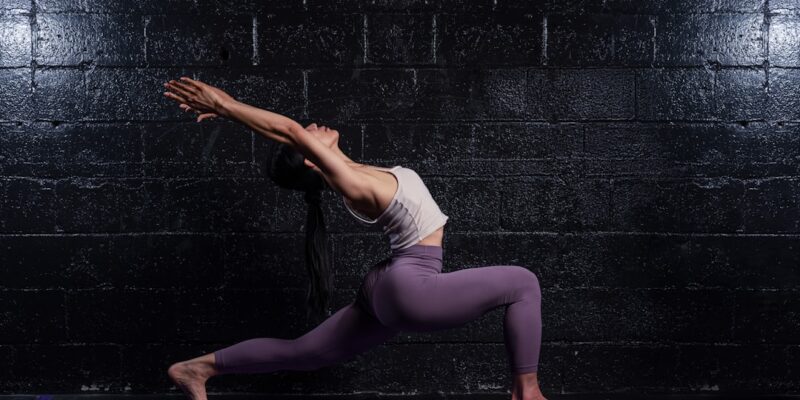
Boost Your Mobility: Flexibility Training for Better Range of Motion
Flexibility training is an often overlooked component of a well-rounded fitness routine. While many people focus on strength training and cardiovascular exercise, flexibility training is just as important for overall health and fitness. Flexibility refers to the range of motion in a joint or group of joints, and flexibility training involves stretching exercises to improve this range of motion. In this article, we will explore the importance of flexibility training, the benefits it provides, and how to incorporate it into your exercise routine.
Key Takeaways
- Flexibility training is important for overall health and fitness.
- Increased range of motion can lead to improved athletic performance and reduced risk of injury.
- Flexibility training can be incorporated into any exercise routine.
- Common flexibility exercises include static stretching, dynamic stretching, and foam rolling.
- Proper technique and gradual progression are key to avoiding injury during flexibility training.
Understanding the Importance of Flexibility Training
Flexibility training is the practice of stretching to improve the range of motion in your joints. It is an essential component of overall health and fitness because it helps to maintain proper posture, reduce the risk of injury, enhance athletic performance, and increase blood flow and circulation.
Proper posture is crucial for maintaining a healthy spine and preventing back pain. Flexibility training can help improve posture by lengthening tight muscles that pull the body out of alignment. By stretching regularly, you can correct imbalances in muscle length and strength, leading to better posture and reduced strain on the spine.
In addition to improving posture, flexibility training also reduces the risk of injury. When muscles are tight and inflexible, they are more prone to strains and tears. By increasing your range of motion through regular stretching, you can improve muscle elasticity and reduce the risk of injury during physical activity.
Flexibility training is also beneficial for athletes and active individuals looking to enhance their performance. Increased flexibility allows for greater joint mobility, which can improve agility, speed, and power. It also helps to prevent muscle imbalances that can lead to decreased performance or injury.
Lastly, flexibility training increases blood flow and circulation throughout the body. When you stretch a muscle, blood flow to that area increases, delivering oxygen and nutrients while removing waste products. This increased blood flow can help improve recovery time after exercise and promote overall cardiovascular health.
Benefits of Increased Range of Motion
Improved posture, reduced risk of injury, enhanced athletic performance, and increased blood flow and circulation are just a few of the benefits that come with increased range of motion through flexibility training.
Improved posture not only makes you look taller and more confident, but it also helps to prevent back pain and other musculoskeletal issues. When your muscles are tight and imbalanced, it can cause your body to compensate by adopting poor posture. This can lead to chronic pain and discomfort. By increasing your range of motion through flexibility training, you can correct these imbalances and maintain proper alignment.
Reduced risk of injury is another significant benefit of flexibility training. When your muscles are tight and inflexible, they are more prone to strains, tears, and other injuries. By regularly stretching and improving your range of motion, you can increase muscle elasticity and reduce the risk of injury during physical activity.
Enhanced athletic performance is another advantage of increased flexibility. When your joints have a greater range of motion, you can move more freely and efficiently. This can improve agility, speed, and power, leading to better performance in sports and other physical activities.
Increased blood flow and circulation is yet another benefit of flexibility training. When you stretch a muscle, blood flow to that area increases, delivering oxygen and nutrients while removing waste products. This increased blood flow can help improve recovery time after exercise and promote overall cardiovascular health.
How to Incorporate Flexibility Training into Your Exercise Routine
| Flexibility Exercise | Benefits | Frequency | Duration |
|---|---|---|---|
| Static Stretching | Increases range of motion, reduces muscle tension and soreness | 2-3 times per week | 10-30 seconds per stretch |
| Dynamic Stretching | Improves flexibility, balance, and coordination | Before exercise or as a warm-up | 10-15 repetitions per exercise |
| Yoga | Reduces stress, improves balance, and increases flexibility | 2-3 times per week | 30-60 minutes per session |
| Pilates | Strengthens core muscles, improves posture, and increases flexibility | 2-3 times per week | 30-60 minutes per session |
Now that we understand the importance of flexibility training, let’s discuss how to incorporate it into your exercise routine. Here are some tips for adding flexibility training to your workout schedule:
1. Set aside dedicated time for stretching: Just like you schedule time for strength training or cardio, make sure to allocate specific time for flexibility training. Aim for at least 10-15 minutes of stretching after each workout session.
2. Mix it up: Don’t stick to the same stretches every time. Incorporate a variety of stretches that target different muscle groups. This will help improve overall flexibility and prevent muscle imbalances.
3. Start with a warm-up: Before diving into your stretching routine, it’s essential to warm up your muscles. This can be done through light cardio exercises like jogging or jumping jacks. Warming up increases blood flow to the muscles and prepares them for stretching.
4. Hold each stretch for 20-30 seconds: When performing a stretch, hold it for 20-30 seconds to allow the muscle to relax and lengthen. Avoid bouncing or jerking movements, as this can lead to injury.
5. Breathe deeply and relax: While stretching, focus on deep breathing and relaxing your muscles. This will help you achieve a deeper stretch and prevent unnecessary tension.
Common Flexibility Training Exercises
There are numerous stretches that target different muscle groups and improve flexibility. Here are some examples of common stretches:
1. Hamstring Stretch: Sit on the floor with one leg extended in front of you and the other bent with the foot resting against the inner thigh of the extended leg. Lean forward from the hips, reaching towards your toes while keeping your back straight.
2. Quadriceps Stretch: Stand tall and grab one foot behind you, pulling it towards your glutes. Keep your knees close together and your torso upright.
3. Chest Stretch: Stand tall with your feet shoulder-width apart. Interlace your fingers behind your back and squeeze your shoulder blades together while lifting your arms away from your body.
4. Shoulder Stretch: Stand tall with your feet shoulder-width apart. Extend one arm across your chest, using the opposite arm to gently pull it closer to your body.
5. Calf Stretch: Stand facing a wall with one foot in front of the other. Place your hands on the wall at shoulder height and lean forward, keeping your back leg straight and your heel on the ground.
Stretching Techniques for Optimal Results
When it comes to flexibility training, there are different stretching techniques that you can incorporate for optimal results. Two popular techniques are dynamic stretching and static stretching.
Dynamic stretching involves moving parts of your body through a full range of motion. This type of stretching is typically done before a workout or physical activity to warm up the muscles and increase blood flow. Examples of dynamic stretches include arm circles, leg swings, and walking lunges.
Static stretching, on the other hand, involves holding a stretch for an extended period without movement. This type of stretching is typically done after a workout or physical activity to improve flexibility and cool down the muscles. Examples of static stretches include the hamstring stretch, quadriceps stretch, and chest stretch.
Another stretching technique that can be beneficial is PNF (proprioceptive neuromuscular facilitation) stretching. PNF stretching involves a combination of contracting and relaxing muscles to achieve a deeper stretch. This technique is often used by athletes and physical therapists to improve flexibility and range of motion.
Tips for Avoiding Injury During Flexibility Training
While flexibility training is beneficial for overall health and fitness, it’s essential to practice proper form and technique to avoid injury. Here are some tips for avoiding injury during flexibility training:
1. Start slowly: If you’re new to flexibility training, start with gentle stretches and gradually increase the intensity and duration over time. Pushing yourself too hard too soon can lead to muscle strains or tears.
2. Listen to your body: Pay attention to how your body feels during each stretch. If you feel any sharp or intense pain, ease off the stretch immediately. Stretching should feel challenging but not painful.
3. Avoid overstretching: It’s important not to push your muscles beyond their limits. Overstretching can lead to muscle strains or tears. Instead, focus on gradually increasing your range of motion over time.
4. Use proper form: When performing stretches, make sure to use proper form and technique. This will help target the intended muscle group and prevent unnecessary strain on other muscles or joints.
5. Don’t bounce or jerk: Avoid bouncing or jerking movements while stretching, as this can lead to injury. Instead, hold each stretch for 20-30 seconds and focus on deep breathing and relaxation.
Flexibility Training for Athletes and Active Individuals
Flexibility training is particularly beneficial for athletes and active individuals looking to enhance their performance and reduce the risk of injury. Here’s how flexibility training can benefit athletes:
1. Improved range of motion: Increased flexibility allows for greater joint mobility, which can improve agility, speed, and power. Athletes with a greater range of motion can move more freely and efficiently, leading to better performance in sports.
2. Injury prevention: Flexibility training helps to reduce the risk of muscle strains, tears, and other injuries commonly associated with physical activity. By improving muscle elasticity and reducing muscle imbalances, athletes can stay on top of their game and avoid time on the sidelines due to injury.
3. Faster recovery: Flexibility training increases blood flow and circulation throughout the body, which can help improve recovery time after intense exercise or competition. By promoting the delivery of oxygen and nutrients to the muscles, flexibility training can help athletes bounce back faster and perform at their best.
Examples of stretches specific to certain sports include:
– Runners: Hip flexor stretch, calf stretch, hamstring stretch
– Swimmers: Shoulder stretch, chest stretch, tricep stretch
– Tennis players: Forearm stretch, shoulder stretch, hip flexor stretch
– Gymnasts: Split stretch, backbend stretch, shoulder stretch
Yoga and Pilates for Improved Flexibility
Yoga and Pilates are two popular forms of exercise that can greatly improve flexibility. Both practices focus on stretching and strengthening the body, leading to increased range of motion and improved overall flexibility.
Yoga is a mind-body practice that combines physical postures, breathing exercises, and meditation. It emphasizes flexibility, balance, and strength. Many yoga poses involve deep stretching and can help lengthen tight muscles and improve joint mobility. Some yoga poses that are particularly beneficial for increasing flexibility include downward dog, pigeon pose, and seated forward fold.
Pilates is a low-impact exercise method that focuses on core strength, flexibility, and body awareness. It incorporates controlled movements and emphasizes proper alignment and breathing. Pilates exercises often involve stretching and lengthening the muscles while maintaining stability and control. Some Pilates exercises that can improve flexibility include the roll-up, spine stretch forward, and mermaid stretch.
Both yoga and Pilates can be practiced by individuals of all fitness levels and can be modified to suit individual needs. Regular practice of these disciplines can lead to increased flexibility, improved posture, and enhanced overall well-being.
Flexibility Training for Aging Adults
Flexibility training is especially important for aging adults as it helps to maintain joint mobility, prevent muscle imbalances, and reduce the risk of falls and injuries. Here’s why flexibility training is crucial for older individuals:
1. Joint mobility: As we age, our joints naturally become stiffer and less flexible. Flexibility training can help maintain joint mobility and prevent the loss of range of motion. This is particularly important for activities of daily living such as bending down, reaching overhead, or getting in and out of a chair.
2. Muscle imbalances: Aging adults often experience muscle imbalances due to a sedentary lifestyle or lack of physical activity. Flexibility training can help correct these imbalances by lengthening tight muscles and strengthening weak ones. This can improve overall posture, balance, and stability.
3. Fall prevention: Falls are a significant concern for aging adults and can lead to serious injuries. Flexibility training can help improve balance and coordination, reducing the risk of falls. By maintaining flexibility in the lower body, older individuals can also improve their ability to recover from a stumble or loss of balance.
Examples of stretches that are safe and effective for older individuals include:
– Neck stretch: Gently tilt your head to one side, bringing your ear towards your shoulder. Hold for 20-30 seconds and repeat on the other side.
– Shoulder stretch: Extend one arm across your chest, using the opposite arm to gently pull it closer to your body. Hold for 20-30 seconds and repeat on the other side.
– Seated hamstring stretch: Sit on the edge of a chair with one leg extended in front of you. Lean forward from the hips, reaching towards your toes while keeping your back straight. Hold for 20-30 seconds and repeat with the other leg.
Combining Flexibility Training with Strength Training for Maximum Results
While flexibility training is important on its own, combining it with strength training can lead to even better overall fitness. Here’s why combining flexibility and strength training is beneficial:
1. Improved performance: Flexibility training helps to improve joint mobility, while strength training builds muscle strength and power. By combining both types of training, you can enhance your overall performance in sports and other physical activities.
2. Injury prevention: Flexibility training reduces the risk of muscle strains and tears, while strength training helps to stabilize joints and prevent injuries. By incorporating both types of training into your routine, you can reduce the risk of injury and stay active for longer.
3. Balanced fitness: Flexibility training focuses on lengthening muscles, while strength training focuses on building muscle mass and strength. By combining both types of training, you can achieve a balanced level of fitness that includes flexibility, strength, and cardiovascular endurance.
To incorporate both flexibility and strength training into your workout routine, try alternating days or dedicating specific sessions to each type of training. For example, you could do strength training exercises on Monday, Wednesday, and Friday, and flexibility training exercises on Tuesday and Thursday. This way, you can ensure that you are giving equal attention to both aspects of fitness.
Flexibility training is an essential component of a well-rounded fitness routine. It improves posture, reduces the risk of injury, enhances athletic performance, and increases blood flow and circulation. By incorporating flexibility training into your exercise routine, you can improve your overall health and fitness.
Remember to set aside dedicated time for stretching, mix up your stretches to target different muscle groups, warm up before stretching, and use proper form and technique to avoid injury. Whether you’re an athlete, an aging adult, or someone looking to improve their overall flexibility, there are stretches and techniques that can benefit you.
So don’t neglect flexibility training in your exercise routine. Start incorporating stretches into your workouts today and reap the benefits of increased range of motion and improved overall health and fitness.
FAQs
What is flexibility training?
Flexibility training is a type of exercise that focuses on improving the range of motion of your joints and muscles. It involves stretching and other exercises that help to increase your flexibility and mobility.
What are the benefits of flexibility training?
Flexibility training can help to improve your range of motion, reduce the risk of injury, improve your posture, and enhance your athletic performance. It can also help to reduce muscle soreness and stiffness, and improve your overall quality of life.
What are some examples of flexibility exercises?
Some examples of flexibility exercises include static stretching, dynamic stretching, yoga, Pilates, and foam rolling. These exercises can help to improve your flexibility and mobility, and can be done at home or in a gym.
How often should I do flexibility training?
It is recommended that you do flexibility training at least two to three times per week. However, you can do it more often if you feel like you need to. It is important to listen to your body and not overdo it, as this can lead to injury.
Is flexibility training suitable for everyone?
Flexibility training is generally safe for most people, but it is important to consult with a doctor before starting any new exercise program. People with certain medical conditions, such as arthritis or osteoporosis, may need to modify their exercises or avoid certain types of stretching.
How long does it take to see results from flexibility training?
The amount of time it takes to see results from flexibility training can vary depending on your starting level of flexibility and how often you do the exercises. However, most people will start to see improvements in their range of motion within a few weeks of starting a flexibility training program.


















